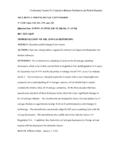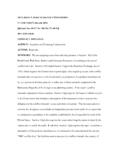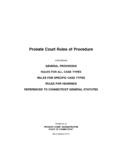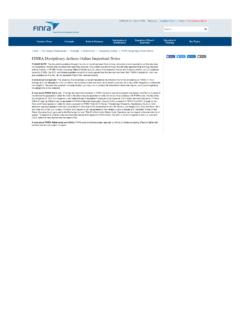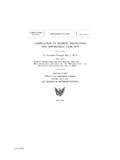Transcription of SEC Custody Rule ‘No-Action’ - …
1 1 SEC Custody Rule No-Action Letter and Additional Guidance - Frequently Asked QuestionsOn February 21, 2017, the Securities and Exchange Commission (SEC) released a no-action letter providing additional guidance on how the Custody Rule applies to third-party money movement authority. This guidance outlines a set of conditions that, when followed, allow RIAs to avoid the annual surprise examination requirement of the rule (aka no-action relief ). The letter also clarified that a standing letter of authorization (SLOA) granting third-party money movement authority is deemed Custody . In addition, while the no-action letter did not directly address the standing authority which allows an advisor to wire money between a client s own accounts at different financial institutions (first-party money movement), the SEC did provide additional guidance on this topic in its revised FAQ , which can be found on its , this guidance provides new perspective on the Custody Rule as it applies to first-party and third-party money movement.
2 Key takeaways include: The guidance directly affects RIAs moving money on behalf of their clients. Previously commonplace transactions may now implicate the Custody Rule. The most important distinctions have to do with authority to initiate first- and third-party created the following FAQs to help advisors understand the implications of the SEC Custody guidance in regards to both first-party and third-party money movement authority, and identify whether or not they may need to consider amending some practices and procedures related to money movement, in order to comply with new information can also be found in the Investment Adviser Association FAQs on this here to access FAQ TopicsKey definitions >Implications of the new guidance: first-party >Implications of the new guidance: third-party > Money movement At-a-glance: is it Custody ?
3 >Other related questions >HomeUPDATED JUNE 20172 Key definitionsQ1. What is Custody ? A. An investment advisor is said to have Custody when they are holding a client s funds or securities, directly or indirectly, or have the authority to obtain possession of them. For example, advisors have Custody when the advisor has possession of client funds and securities or has power of attorney to sign checks on a client s behalf, to withdraw funds or securities from the client s account, including fees, or to otherwise dispose of a client s assets for any purpose other than authorized trading. Schwab cannot tell advisors which specific arrangement qualifies as Custody , and we suggest you seek guidance from a compliance or legal advisor. You can also review the information on the SEC How does the SEC define first-party money movements and third-party money movements?
4 A. At the time of writing, the SEC has not provided explicit definitions for first-party money movements or third-party money movements. Schwab is continuing to define first-party and third-party money movements in the same way that we have traditionally. Below we have outlined Schwab s definitions. These definitions may vary from those used by other institutions or regulatory How does Schwab define first-party money movements and third-party money movements?A. Advisors will need to make their own determination about whether a money movement is first-party or third-party for the purpose of complying with the new guidance. Schwab defines these as follows: First-party refers to money movements where cash or assets are disbursed between two of the client s accounts, where both accounts have the same-named registration.
5 Similarly, a first-party check would be one in which the funds are sent from an account where the name on the registration is identical to the payee, and sent to the address of record for the account. For example, a money movement from John Smith s Schwab account to John Smith s XYZ bank account would be considered first-party at Schwab. Schwab s definition for first-party may be different from yours or other institutions, so please consult with your legal and compliance professionals. Third-party refers to money movement where cash or assets are disbursed between two accounts with different named registrations for example, a money movement from Jane Doe s Schwab account to John Smith s XYZ bank account. In this case, John Smith is considered a third party. Schwab also considers a money movement from an individual account to a joint account and vice versa to be a third-party money movement for example, Jane Doe s Schwab account to Jane Doe s joint account at XYZ bank.
6 Schwab s definition for third-party may be different from yours or other institutions, so please consult with your legal and compliance professionals. Specifically, the SEC may not consider money movement from an individual account to a joint account and vice versa to be third-party money movement, although Schwab does. Similarly, the SEC may not consider money movement between an IRA account and a brokerage account in the same name to be third-party, but Schwab does. Q4. My firm handles a wide variety of money movements on behalf of my clients. How can I know whether or not a given disbursement would constitute Custody ?A. The SEC has provided guidance clarifying when first- and third-party money movement authority may implicate the Custody Rule. However, since we cannot be certain that the SEC s determination on whether a disbursement was first-party and third-party would be identical to Schwab s, we can only provide guidance based on Schwab s definitions of these terms.
7 As Schwab s definitions may be different than yours or other institutions, please consult with your legal and compliance here to access FAQ TopicsKey definitions >Implications of the new guidance: first-party >Implications of the new guidance: third-party > Money movement At-a-glance: is it Custody ? >Other related questions >Home3 Implications of new Custody Rule guidance: First-party money movementsQ5. How does the guidance from SEC impact first-party wires?A. According to the updated guidance provided by the SEC in its FAQs, advisors with standing first-party wire authority may have Custody . For an advisor to avoid having Custody , his or her client must provide the sending custodian a signed first-party wire authorization specifying the receiving account number(s) at the outside financial institution at the time the authorization is granted.
8 We have additional information and resources throughout this document providing more detail on how your firm can avoid Custody . Q6. I have standing first-party money movement authority to wire my client s assets between their accounts at Schwab to other /financial institutions. Based on the guidance, could this be considered Custody ?A. Yes, the SEC clarified that an advisor who has standing first-party money movement authority to send wires (found under Trading and Disbursement Authorization on the Schwab account application) has Custody . To avoid Custody , you will need to remove the wire authorization given to you by your client or have them provide signed written authorization stating the name and account numbers on the sending and receiving accounts in advance of the transaction. See additional information below on when you will be able to make these changes if you wish to do Will you be updating Schwab forms so they can include their account number, in order to help me avoid Custody ?
9 A. Yes, Schwab will be amending its forms to allow advisors to capture the necessary information. By fall 2017, we will roll out changes to systems and forms that will allow advisors to meet these requirements, while still supporting their clients need to make I use Schwab MoneyLink (aka ACH) to move money from my client s account at Schwab to his or her account at a different custodian or financial institution. Could this be considered Custody ?A. Since the MoneyLink form requests the name and account numbers on the client s sending and receiving accounts as part of the initial authorization, outgoing first-party money movement would not be considered Custody at Schwab. MoneyLink may also be used for third-party EFT/ACH transactions at Schwab, which have different Custody implications than first-party. (Please see below under Implications of the new guidance: Third-party.)
10 Q9. How long do I have to make changes?A. While the SEC did not specify a deadline by which advisors and custodians must make any necessary changes, they do understand that it will require a reasonable period of time to implement new processes and procedures. In discussions with SEC staff in February, it was suggested that 6-12 months may be required for most firms to make the change, and that some firms and custodians may require more time, based upon their own facts and circumstances. Given this guidance, advisors should make a good faith effort to comply with these requirements with the understanding that the SEC staff views implementation timing with some flexibility. With regard to first-party money movement, Schwab is targeting late summer to have the necessary changes in place that will allow you to take action.
